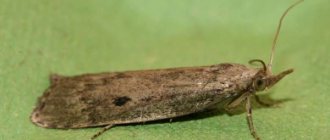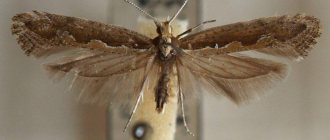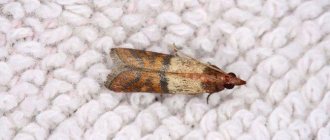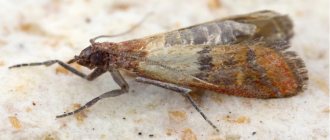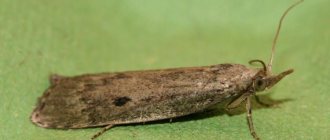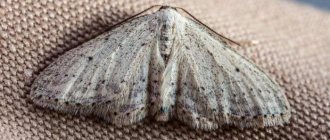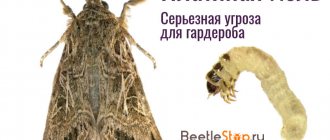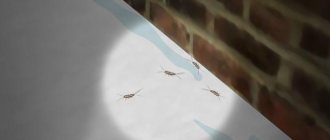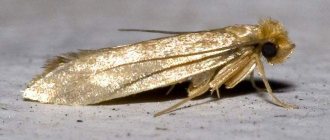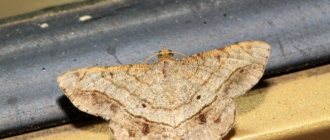Clothes and kitchen moths, or as they are also called - food moths, are the most common household pests that are found in the home. They tend to hide well, so insects can only be discovered when they are disturbed. Therefore, the owners learn about the extensive infestation only after the moths have already damaged woolen fabric, valuable fur or food products that can only be thrown away.
In this article, we will remind our readers of the main differences between moths and other types of completely harmless insects, briefly mention the life cycle of these insects, and also tell you how to get rid of clothes moths in your wardrobe.
How to distinguish between food and clothes moths
Clothes moths are usually more common than food moths. Their appearance is very similar, with the exception of some features identifying the species. Adult clothes moths are often golden in color with reddish hairs on the top of the head. Also, a row of golden hairs border the insect's wings, which have a span of about 1 cm. Since these pests are blinded by daylight, they are more often found sitting in dark areas of the closet or behind it.
Clothes moth
Clothes moths should not be confused with insects that parasitize food. This species tends to be much smaller in size and has a darker brownish-gray color. At rest, the insects are about 0.5 cm long, while most clothing pests are much larger.
Both species usually only fly around the immediate area where the infestation has occurred. In addition, they are characterized by a unique flight pattern. Fluttering and spiraling movements are the main distinguishing features of these gray butterflies from other species of nocturnal insects.
The larvae of both species are virtually identical, except that this stage of the clothes moth's life cycle always spins a fine, silky web as they feed. Subsequently, this web serves as the basis for weaving a future cocoon.
Among other things, clothes moth excrement may contain dyes from fabric fibers, which they accepted as food. Therefore, the presence of colored sand grains should indicate the presence of this species.
food moth
Reasons for appearance
Many people wonder where food moths come from in a house where regular cleaning is carried out. She cannot accidentally get into the apartment from the street, since she is not capable of flying that well. Those butterflies that flutter indoors are males. Female moths move much more slowly, mostly hopping from place to place. Therefore, even if a male individual has flown into a dwelling, it will not be able to reproduce without a female one.
Food moths appear in the house along with contaminated cereals, sugar or dried fruits brought from the store.
Inside the bags there are already eggs or moth caterpillars, which then spread throughout the apartment. They get there through cuts, tears, punctures in the packaging or during packaging of goods at the factory.
Comfortable conditions for the reproduction of food moths are a temperature of +22...25°C and air humidity above 60%.
Life cycle
Females of both species lay an average of 40 to 50 eggs over a 2-3 week period and die once the laying process is complete. Males live longer than females and continue to mate for the remainder of their lives. The eggs hatch within 4 to 10 days, provided environmental conditions are favorable.
In total, clothes moth larvae molt from 5 to 45 times, depending on the temperature in the room and the type of food available. The larval period lasts from 35 days to 2.5 years. It is during this period that the greatest damage from insects is observed.
Moth larvae are shiny white, and their head capsules are dark in color. As they feed, the worm-like insects rotate, simultaneously producing a web in which they gradually envelop themselves. When the larvae are ready to pupate, they crawl away from their food source to find a deeper crevice, crawl into it and the pupation process begins.
Pupation lasts from 8 to 10 days in summer and from 3 to 4 weeks in winter. Heated buildings allow moths to continue to develop during the winter months. Typically, the time for development from egg to egg is four to six months, with an average of two generations per year.
Reproduction
Males look for females by a specific smell. Just 4 hours after mating, the insect gives birth to a new generation. Eggs are laid in portions, one clutch reaches 60 eggs. Pests have no seasonality in development and reproduction. Butterflies also hatch unevenly. The most optimal temperature for rapid reproduction of the pest varies from 15 to 30 degrees Celsius. The higher the temperature in the living room, the faster the larvae hatch from the eggs.
Damage
The larval stage of the insect is the destructive stage of the moth's life. Insects feed on the wool of outerwear, carpets and rugs, as well as upholstery of upholstered furniture, furs, animal hair, felt pads in musical instruments and even fishmeal, which is found in abundance in fish food.
Moths will eat synthetic or cotton blends if these fabrics also contain wool. In addition, the pest larvae can also use cotton fibers to make a pupal base.
Characteristic damage usually appears in hidden places, for example, under collars or cuffs of clothing, in the crevices of upholstered furniture, as well as on carpets, some of which lie under furniture. It is worth noting that fabrics contaminated by food, sweat or urine stains are more susceptible to damage by pests due to their attractive aroma.
How to get rid of clothes moths
Methods to control moth populations include periodic dry cleaning, laundering, proper storage, freezing, heating, fumigation, or the use of insecticides. Maintaining low humidity levels inside buildings creates an environment that is not conducive to moth development.
Room walls that don't have numerous tiny cracks and crevices will also encourage fewer pest infestations. Effective practices of good and meticulous housekeeping are essential. It is also important to regularly monitor long-term stored fabrics and the inner surface of wardrobes, preventing their first damage. This approach makes it possible to take action when the infection has not reached significant levels.
Regular monitoring
In order to check for the presence of pests, the first thing you need to pay attention to is whether there are threads of cobwebs in hidden parts of clothing. It is also possible that there are tubes left behind after insects pupate. The area where these tubes are most common tends to have a lot of damaged clothing fibers and insect feces. The same picture can be observed in fur items, where, among other things, baldness can be observed, and when lightly tugging on the remaining fur, it will separate in large clumps.
Preventing or reducing infestations
Periodically cleaning "danger" areas in the home that may harbor moths can completely prevent the insects from appearing. These areas include not only hidden areas on woolen clothing, but also areas outside the closet itself, such as under heavy pieces of furniture, along baseboards and in cracks where hair, dog hair and other debris accumulate.
It is worth paying attention to the space behind the heating radiators and inside the ventilation openings.
A vacuum cleaner is the best tool for most basic methods of such processing. After using the device in areas known to be infested, the contents of the bag should be removed as quickly as possible from the home, since there may be many eggs, larvae or adults inside that can quickly return to the living environment.
Moths may initially establish themselves on woolen items or wool scraps that have been stored for long periods of time. In addition to storing woolen items properly, they should be periodically exposed to the sun and cleaned most thoroughly, especially along seams, inside folds and pockets. A natural fiber brush removes eggs and exposes larvae. In addition, the larvae do not like bright light, so they themselves will try to fall off the clothes as soon as possible.
If the infestation is observed in a closet, be sure to remove all clothing and fabrics stored inside. You should then thoroughly vacuum and wash all interior surfaces, especially cracks and crevices, before returning clean items. Powdered insecticides containing pyrethroids or pyrethrins, such as 0.05% Deltamethrin or 1% Pyrethrin, can be applied to cracks and crevices. Before using chemicals, you should always comply with the requirements indicated on the label.
Prevention
Housewives are interested in how to store cereals and things in the house so that moths do not appear.
There are a number of rules for this:
- You should not buy a lot of cereals, nuts, tea at once. It is better to replenish supplies as needed.
- Cheap loose cereals may contain insect larvae, so you need to purchase cereals in hermetically sealed packs and bags.
- Periodically check existing supplies for the presence of the parasite and its larvae.
- It is worth storing provisions in glass or metal containers.
- You need to place bunches of aromatic herbs on the kitchen shelves and in the closet. They need to be changed as the smell dissipates.
- After purchasing the cereal, you should immediately bake it in the oven. Old stocks that are not visually infected are also kept there for about 15 minutes. In winter, grains can be frozen as an alternative.
- It is not recommended to create significant accumulations of garbage in the house in the form of old things, carpets, pillows.
Sources
- https://dezplan.ru/vopros/mol-v-krupe
- https://obnaruzhil.ru/mol/pishhevaya.html
- https://FB.ru/article/268051/mol-v-krupe-kak-izbavitsya-sovetyi-po-borbe-i-hraneniyu-krup
- https://parazitdoma.ru/mol/mol-v-krupe
- https://Dezoff.ru/mol/pishchevaya-mol/
- https://KatalogPoleznogo.ru/dom/pishhevaya-mol-na-kuhne-32-sposoba-vyivesti.html
- https://apest.ru/mol/vse-o-moli/zavelas-mol-v-krupe-kak-izbavitsya/
- https://GdeKlop.ru/mol/kak-izbavitsya-ot-moli-v-krupah/
Dry cleaning and anti-laundering
The most common and effective method for killing all life stages of moths in clothing, blankets and other washable items is classic washing or laundering. A thorough washing process should not take less than 20-30 minutes in water that is heated to at least 50 degrees Celsius. Since many woolen items should not be washed in hot water, dry cleaning these items may be the only viable option. Storing clean fabrics has another benefit - insects are less likely to infest them.
Protecting things in the closet
Moths often damage improperly stored items. When storing pest-sensitive fabrics, make sure the items are clean and free of pests, then place them in a sealed plastic bag. Additionally, before sealing the bag, you can place repellents inside, for example, spray with lavender essential oil.
Naphthalene or crystals containing 1,4-dichlorobenzene, also called paradichlorobenzene, are also widely available to protect clothing during storage.
Since these materials are toxic, be sure to keep them away from children and pets. These products have other disadvantages as well. For example, they leave an unpleasant odor on clothing and other objects, so if such products come into contact with plastic snaps, grab bars or garment bags, they can deteriorate the plastic and soften and melt synthetic fabrics.
When such chemicals evaporate, they produce fumes that, in sufficient concentration, will slowly kill insects. Vapors accumulate to the required concentration only in a sealed container. If the container is not airtight, the chemicals will only slightly repel adult moths, but they will be useless against the larvae.
The effectiveness of cedar wood is a controversial issue. Aromatic eastern red cedar, or Juniperus virginiana, contains an oil that can kill small grubs, but it has no effect on large grubs. In addition, after several years, cedar loses this quality, so using pressed essential oil is always more effective than a chest or cabinet made of cedar wood.
Therapy
Treatment for moth allergy may include traditional pharmacy products and medications (table below).
| Drug treatment | Traditional medicine |
| · Taking antihistamines (Zyrtec, Zodak, etc.). · Use of products containing cromoglycic acid (sprays, drops and solutions for inhalation). · Use of glucocorticosteroid ointments to relieve skin symptoms (Triderm, Lorinden, etc.). · Use of sorbents (activated carbon, Lactofiltrum) to cleanse the body of allergens. | Tea tree oil is used to get rid of insects indoors (moths react to its smell): · drop a little oil on a piece of cloth and place it in a closet with clothes; · use oil when washing your hands, adding the product to liquid soap; · wash clothes by placing 5-6 drops of oil in washing powder. |
To get rid of moths you can use:
- mint;
- naphthalene;
- tobacco;
- citrus fruit peels;
- geranium;
- vinegar with garlic;
- thyme;
- rosemary, etc.
The symptoms of moth allergy can be cured in a fairly short time, but the disease cannot be eliminated forever. If you pay close attention to your health, follow preventive measures and doctor’s recommendations, the patient’s quality of life will not deteriorate after therapy.
Almost all moths actually do not have a proboscis. But this does not mean that a moth is not a butterfly. But why moths don’t have a proboscis is a really interesting question, and evolutionary biologists who are well versed in the peculiarities of the biology and life activity of these insects can answer it.
Freezing and heating
You can also control moth populations by heating the infested item in an oven for at least 30 minutes at a temperature above 50 degrees Celsius, after placing the accessory in a plastic bag. In the same form, things can be frozen in the freezer for several days at temperatures below minus 20 degrees. Before using any of these methods, it is imperative to take into account the possibility of damage to the fabric by cold or heat.
Deliverance is possible
How to get rid of moths? This process is quite labor-intensive and time-consuming. Today, the following methods are used to control and influence the moth population at home:
- regular dry cleaning;
- wet cleaning (washing) of premises and utensils for storing bulk products;
- freezing or heating food;
- fumigation and use of insecticides.
Each of these methods has its own advantages. In addition, the effectiveness of moth control is significantly influenced by general conditions and cleaning, periodic monitoring of the storage conditions of things and products that are the most “tidbits” for moths.
When cleaning, it is necessary to use complex methods that combine detection, localization and destruction of foci of infection. An important place in the set of measures to prevent the appearance of these pests is occupied by the timely identification of places where they accumulate: various cracks in the walls, under baseboards, under furniture, and so on. It is recommended to store bulk products in airtight containers. Wearable clothing that is not worn frequently should be dried regularly in full sun. Excellent results are achieved when using various chemical control agents: the same naphthalene or essential oils (lavender, cedar). Special moth traps based on pheromones secreted by male moths are also effective.
Traps
Traps are a relatively easy-to-use method that can help detect and reduce clothes moth infestations. Pheromone traps are available in specialty stores and are relatively inexpensive. Pheromones are chemicals produced by the body of a male insect, which in this case is a sex attractant that can influence the behavior of other members of the same species.
The sex pheromone lures females into the trap, where they become stuck on its sticky sides. Since the pheromone specifically attracts only moths, it will not attract other types of insects.
Use of insecticides
If moths are found on things that cannot be dry cleaned, washed, heated or frozen, you will have to treat them with chemical insecticides. Finding a product that contains a picture of a moth on the label is not difficult, you just have to specifically follow the instructions on the back of the package.
Insecticides for clothing moths usually contain pyrethrins, which provide a quick knockdown of the insects. You can spray most of these products directly onto fabrics. Pyrethrin-based insecticides do not leave a persistent toxic residue, making them more suitable for controlling clothes moths.
However, some sprays have an oil base and should not be sprayed on silk, rayon or other fabrics that are easily stained. Also, do not use sprays around open flames, sparks, or electrical circuits.
If in doubt, I would like to share the following information as advice. First, spray a small amount on an inconspicuous area of your clothing and let it dry to see if staining or staining occurs.
What harm does
The insect is not dangerous to humans. It does not bite and does not carry infections on its paws that threaten people. Kitchen moths do not eat clothes made from natural fabrics, so you don’t have to worry about the safety of your items.
Gray moths only harm products: a large number of food moth larvae feeding on groceries spoil them irrevocably.
Supplies become unsuitable for consumption or further processing. All that can be done is to quickly get rid of spoiled cereals or dried fruits to prevent contamination of other food supplies.

